What's new in artificial lift
ARTIFICIAL LIFTWhat’s new in artificial liftPart 2 – Twenty-one new downhole / surface systems for electrical submersible pumping (ESP), and other artificial-lift technologyJames F. Lea and Herald W. Winkler, Texas Tech University, Lubbock, Texas; Henry V. Nickens, BP Amoco, Houston; and Robert E. Snyder, Editor Part 1, presented last month, covered 22 recent developments in five categories of artificial-lift technology: beam pumping, progressing cavity pumping, hydraulic pumping, pneumatic lift and plunger lift. This article introduces 21 recently introduced innovations from 12 companies. Sixteen of the presentations introduce new downhole and surface ESP systems. Five additional "miscellaneous" innovations cover other artificial-lift applications. Electrical Submersible Pumping Described here are 11 innovations for downhole equipment that involve ESP pumps, motors, separators and cables, plus five ESP surface control, protection, operation-simulation / optimization and environmental-containment systems. Subsea ESP completions reach record level. Reda Production Systems, a Schlumberger Company, Bartlesville, Oklahoma, helped form a JIP project funded by the European Commission and six oil operators for a review of nonviable offshore field developments. Subsea applications of ESPs have turned marginal or unprofitable fields into profitable producers, Fig. 1. The greatest distance for a subsea ESP step out from the host power supply is in excess of 15 km (24 mi). The total number of ESPs in subsea applications has reached more than 25 successful completions. Reda has supplied 100% of the subsea ESP systems now installed.
High-performance gas separator. Reda Production Systems introduced the second in a new line of high-performance Vortex Gas Separators, the 538 Series VGSA S70-150. This newly designed gas separator offers greater efficiency in higher-flowrate applications. Improved hydraulics, coupled with Reda’s compliant-mount radial bearing system, provides high reliability. Fig. 2 shows a performance comparison between the 538 Series system and other gas separators for liquid flows up to 12,000 bpd.
Downhole gauge. Schlumberger developed the PumpWatcher Sapphire four-channel downhole gauge for ESP systems. The tool measures downhole conditions in real time using a patented method of digital transmission. The high-precision gauge provides continuous pressure and temperature measurements at the pump intake and discharge head, Fig. 3.
Measurement of pressure produced by the pump is used to indicate flow, pump efficiency and pump wear. Monitoring motor temperature prevents operating the pump in adverse conditions. Data is transmitted on the ESP power cable, eliminating need for an "I" wire. This feature simplifies installation, improves reliability and reduces total system cost. Digital telemetry is not affected by electrical noise. Surface readout for downhole instrumentation. Reda Production Systems has developed a new surface unit to operate with its line of downhole monitoring equipment. The WB2 provides power to the gauges, demodulates the signals, stores and conveniently delivers data. The optional SD1 Smart Display is used to read measured parameters directly at the wellsite. The small, robust display can be secured in place or carried to multiple installations. The rugged WB2 is totally enclosed in a NEMA enclosure, Fig. 4, and is rated for operation between – 55°C and 75°C ( – 67°F and 167°F) ambient temperature. All data connections are isolated from supply voltage by solid shields to increase safety. There are four analog outputs, eight digital outputs and connections for Modbus to provide local and remote control – Modbus 232 and 485 protocols are supported. A communications port readily connects a laptop or similar PC device.
Downhole power cable. Wood Group ESP of Oklahoma City, Oklahoma, has introduced a newly designed downhole power cable. Tradenamed Powerline, the cables are designed with the toughest oilwell environments in mind. Three standard cables are currently available: the 205, 300 and 450. The 205 has an operating temperature range of – 5 to 96°C and is available in voltage ratings of 3, 4 or 5 kV. It has a polypropylene insulation, a nitrile rubber jacket and choices of armor. Fig. 5 represents typical product lines with round and flat versions.
Powerline 300 is an EPDM-insulated cable with a rubber or EPDM jacket. It is designed for moderate-to-harsh environments and operating temperatures below 149°C. The 450 is the choice for extremely harsh environments, with EPDM insulation and a lead jacket. The operating range of temperatures for this cable is – 40 to 232°C; and it is configured in parallel only.
High-efficiency motors. Wood Group ESP has released its E4 and E5 series high-efficiency motors for 5-1/2- and 7-in. casing, respectively. Incorporating newly designed stator and rotor laminations, these motors operate at higher efficiencies and produce more horsepower per length than standard motors. Fig. 6 represents a cross-section of the E5 series. Fully compatible with the company’s current product lines, the E-series motors offer an all-steel, open-slot stator and "teardrop" rotor bars, both of which will result in increased operating speed and efficiency. The E4 offers hp ranges from 25 to 150 hp in a choice of voltages. The E5 series ranges from 35 to 315 hp. Labyrinth seal. Also new from Wood Group ESP is a labyrinth seal section. The 98L seal has a totally re-designed thrust bearing and runner. The runner’s thickness has been increased to a load capacity of 5,500 lb, and a tilting-pad bearing surface is utilized. To reduce influence of well fluid on the thrust bearing, it has been moved to the bottom of the seal section. This allows for two mechanical seals above the thrust bearing rather than the one conventionally found on most labyrinth seals. Application guidelines are available. Skid-mounted system. Centrilift, a division of Baker Hughes, Claremore, Oklahoma, now offers desert-drive, skid-mounted systems that allow platform or field operators to install ESP variable speed drive (VSD) equipment in arduous, hot desert environments. The VSD skid system is fully portable and can be operated outdoors without need for an air-conditioned switchroom building, Fig. 7. With the package, installation operators can locate the drive equipment outdoors close to the wellhead, in hot ambient locations, without need for expensive air-conditioned switchrooms.
Containment system. Centrilift’s drive-containment system allows platform or rig operators to install ESP variable speed drive equipment in hazardous-rated areas, Fig. 8. Before this development, drive systems had to be located in nonhazardous areas for safe operation. The system is especially suited for projects with a short duration or on long-term projects that do not have sufficient safe-area space available for location of standard VSD equipment. With the system, installation operators can locate the drive equipment close to the wellhead in Hazardous Zone 1 or Zone 2 rated areas. Simulator screen. Since Centrilift’s release of Version 1.1 in 1995, AutographPC has gone through several major upgrades each year. The most exciting feature yet is called the Simulator option, which adds the time variable to sizing to view well dynamics operation, in conjunction with the pump operating point, Fig. 9. The system can accelerate or slow time, start / stop the pump or change fluid characteristics like watercut – all while simultaneously recording changes in parameters like pressure, flowrate, amps and others. This virtual simulation enables users to match active well performance to predicted performance, plus use this information to optimize production and equipment run life.
The scope includes well performance and sizing of the centrifugal pump, motor, seal, cable and controller based on customer-provided well data and production requirements. With the latest release, the program can also size tapered pumps, ESPCPs and SubSep (downhole oil / water-separation system). Besides sizing, AutographPC can also compute and check bending-stress levels that occur when passing equipment through doglegs, with the included ASAP (A Stress Analysis Program) routines. Dual-boost pump system. Centrilift has broken new ground for customers in Ecuador by completing some of the world’s most difficult and unique oilwell pump systems. The company has been behind several new developments, including the world’s first double- and triple-booster oilwell pump completions, Fig. 10. Eight of these unusual booster pump systems were installed in Ecuador in 1999, and six more are slated for this year. Ecuador was also the site where the company completed the industry’s first "separate-formation" completion, in which two pumps are placed in the same hole with each producing oil from a different formation. Even though the pumps are situated in the same well, fluid from each formation remains isolated to the surface. Large-motor development. Centrilift has expanded its 725 motor series (which will fit in 9-5/8-in. casing) to include motors up to 2,000 hp that can produce over 60,000 bpd in oilfield conditions. With casing up to 36 in., these pumps can lift 6,700 gpm for mine dewatering. The 725 series motors will operate in wells with BHTs up to 400°F. With these new systems, operators can now drill deeper and produce more in smaller-diameter wells with higher-horsepower motors – even in high-temperature environments.
Surge protection de-vices. MVC, Inc., Amarillo, Texas, is a manufacturer of surge protection devices designed for voltages of 40 VDC to 4,160 VAC applications. The MV Series (120 to 480 V applications) offers one of the highest degrees of protection against line noise transients, Fig. 11. They have been tested through UL labs and hold a UL 1449 2nd Edition listing. They carry a full five-year, unconditional warranty. The WS Series (1,500 to 4,160 V applications) has been specifically designed for medium-voltage motor and pump applications. These units have replaceable modules and considerably extend motor, pump and control life. The ICP Series was specifically designed for individual-circuit protection such as programmable-logic control (PLC) and solid-state controls. These units are built in either parallel or series configuration, according to requirements of the customer. The ICP also has a remote alarm, which allows the user to monitor surge-protection devices (SPDs) from a computer terminal located miles away. All MVC surge-protection devices are externally fused for safety and have failure indicators. Cable insulation protection. Years of experience trying to extend ESP run life has caused the industry to adopt a "floating" electric power connection. This connection allows continued operation with one phase shorted to ground. Total failure occurs when a second phase shorts to ground. Many ESP failures are still associated with thunderstorms or power outages. With no limit to the peak insulation voltage, there is nothing to limit insulation degradation. Such degradation and, ultimately, failure relate to partial discharges that cause carbon tracks or "trees" to grow in the insulation between phase wires and ground. To solve these problems, PM&D Engineering, Inc., in Bluffton, Indiana, has introduced a transient-voltage surge suppressor (TVSS), called Pro-MoDr, designed specifically for floating, constant-frequency ESP installations. Mounted in the junction box to minimize ground-wire inductance, Fig. 12, it provides full line-to-line and line-to-ground protection with UL 1449-listed surge-suppression devices. A three-lamp circuit indicates a line-to-ground short. By limiting the peak voltage that can be applied across cable and motor insulation, the system greatly reduces partial discharges, thereby increasing the life of ESP insulation.
Reeled ESP completion system. ReELIFT, offered by Innovative Engineering, Aberdeen, is a reeled completion system that utilizes ESPs as the means of lifting liquids. It comprises the required surface and subsurface assemblies – with the exception of the ESP. There are two system series: "C" is used with conventional pumping technology – motor at the bottom, Fig. 13. "I" is configured for wells that require inverted pumps – motor at the top of the ESP assembly. Both series utilize the electrical power cable placed in the internal of the CT.
According to the supplier, the system:
It can be used with conventional, as well as inverted, pumping to allow flexibility in pump / supplier choice. It incorporates subsurface flow control for well safety and reservoir isolation. And it provides a release / circulating system for safe well circulation / control, disconnect and effective completion retrieval. The surface assembly is a compact production spool connected to the cable / coiled-tubing assembly which houses the cable. The subsurface assembly comprises elements from the bottom of the CT string to the pump assembly, depending on the configuration selected. For the two main completion system options, the surface and CT assemblies are common and almost identical. Series C systems are designed for wells requiring packer-type completions using conventional ESP technology. This configuration has the cable inside the CT string. A packer-type completion allows the ESP to discharge fluids through the packer and crossover into the annular space using a flow diverter located at the top of the packer. A hydraulic, surface-operated flow control is located at the pump discharge for isolation and well control. The cable is connected to the surface facility using conventional connectors. The Series I is designed for inverted (bottom-intake) ESPs. The subsurface assembly comprises cable-termination and isolation devices at the top of the pump assembly (top of motor also) and a release / circulation device, which allows well neutralization and release (disconnect) from the ESP assembly. The subsurface assembly incorporates a pump discharge sub based on packer technology. This flow diverter, placed between pump and motor (or seal), provides isolation between suction and discharge sides of the pump assembly and allows flow to cross from pump internals into the annular space. Downhole, twin-screw multiphase flow pump. CAN-K Process & Mining Equipment Ltd., Edmonton, Alberta, Canada, announces development of a downhole, all-metal, twin-screw multiphase flow pump. Typically, this type of pump has been manufactured as a large-dimension, large-capacity surface pump used to transmit multiphase flow where separation is not available, such as offshore. CAN-K’s patented pump is a new downhole application of the concept. The pump is designed in modules; each has a certain pressure and volume capability, depending on the screw and also clearances and other design parameters. Each module is designed to take up to 300 bpd at 60 bar (870 psi), depending on fluid characteristics. It can pump 900 bpd at 3,500 rpm using a downhole electric motor. To increase the volume, modules have to be added or the screw profile altered. To increase pressure, secondary modules can be added or screw and housing and / or screw clearances changed, depending on pressure requirements and fluid. Most of the pumps use the same parts except for screws, housings, shafts and seals. These are selected according to operating conditions. In most cases, custom-designed journal bearings, both split and solid, are used. Axial loads are balanced by the two pairs of opposing screws. NPSH of one meter is desirable, but not essential. The pump will transfer fluid from one module to the other, depending on well depth and volume required. Stages can be added as required. Shear rate is low compared to other pumps – this reduces losses within the pump. The pump is claimed to use less than 40 – 60% of the hp of a comparable PCP. Specially-designed pumps can handle temperatures to 480°C. Standard pumps will withstand up to 150°C. The downhole motor is used to run at high speeds, and a custom-designed centralizer is used to connect the motor with the pump. In the situation where power is supplied by use of a rotating sucker rod, the gearbox is used to centralize the rod, as well as increase speed at the pump. The gearboxes are the planetary type, with very high-torque capability. Miscellaneous Five items under this category cover a capillary tubing system, a wellhead controller, a downhole water-injection tool, a remote service rig monitor and an improved corrosion inhibitor Capillary tubing injection system. Although it has been previously reported in an earlier "What’s New" feature, Downhole Injection Systems, Oklahoma City, Oklahoma, has improved its concentric capillary-tubing system. This system allows lubrication of small tubing down the existing production tubing. Using this system, surfactant to unload gas wells or corrosion / scale inhibitors can be injected at the bottom of the well. The corrosion-resistant coiled tubing used is 1/4-in.-OD, 0.035-in.-WT, Duplex Stainless Steel 2205 alloy. The system can presently be run to depths of 24,000 ft, with an average installation time of 3 hr, start to finish. The tubing can be pulled and re-run into the same well, or another well, at minimal cost. Installation can be made in a flowing well without interruption of production. No workover rig is required, as the system includes the spooled tubing and equipment necessary to lubricate the tubing into the well, Fig. 14.
A case-history example involves liquid loading in two wells. The FTP is 220 psi and the SITP is 580 psi. The wells were shut in for 24 hr every 3 – 5 days to allow sufficient pressure buildup for unloading the produced water, causing a loss of 6 – 10 days of production per month. The DIS system was installed with 1/4-in.-OD, 0.035-in.-WT, DSS 2205 tubing. The BHA of the small tubing was set at 19,500 ft. Currently, both wells average over 2 MMscfgd and 125 bwpd, and no longer require shut-in periods to produce. Estimated payout was about one month. Wellhead controllers. Automation Associates of Midland, Texas, added new products to its line of wellhead controllers. In addition to the generic RTU (Model 2) that handles most control functions at the wellhead, a line of "purpose-specific," low-cost controllers was developed, Fig. 15. The new ProLift line includes pump-off control for beam pumping units, a proportional response (auto-adjust) plunger lift controller, and a low-cost PCP pump-off controller. The lower cost is achieved by reducing functionality to the minimum required for the application.
These controllers offer additional options. They have an RS 232 output that enables telemetry capability with addition of a modem and radio. The intelligent controller helps optimize producing-well operation and provides operational history. The last 30 days’ runtime and last 30 cycle times are kept. All units have a keypad and display which scrolls to display operational data and control parameters such as: current state, time in current state, operational status, off time, alarms and malfunctions. The pump-off controller requires no end devices on the pump unit. It uses motor power consumption to detect pump-off and a signal from a current transformer installed in the motor control panel to calculate power consumption. When a well pumps off, it becomes rod heavy, and power consumption drops. In the case of a rod part, the controller will claim a fault and go to manual-restart mode. It also has the capability to monitor for increases in power consumption, e.g., if scale, paraffin or other problems stick the rods or pump.
The plunger controller is an intelligent / proportional-response controller. It automatically adjusts off time or after flow to optimize production operation. It is powered by a 6 V battery and solar panel. The ProLift progressive cavity controller operates in a manner similar to the pump-off controller. It also uses motor power consumption to detect pump-off. In PCP operations, the logic is reversed. Power consumption in-creases when PCPs pump-off due to lack of lubrication and increased friction between rotor and stator. The controller also has the capability to detect rod parts. Downhole water injection tool. Available from Chriscor, a division of IPEC Ltd., or Kudu Industries Inc., both in Calgary, Alberta, Canada, the downhole tool is designed to inject water into permeable zones, above or below gas production, to prevent liquid loading in the tubing and increase gas production. The tool is installed in the tubing string in conjunction with a standard packer and an on / off tool, Fig. 16. The packer is positioned above the injection zone, separating it from the producing zone. A conventional API insert pump is run into the string and seated into the tool. The tool can also be operated by a downhole PCP. At the perforations, gas and water separate naturally in the tubing-casing annulus. Gas flows up the annulus to the surface. Water is drawn into the tool by the pump and discharged into the tubing string. Gravity then forces the water around the outside of the pump, through the tool, the on / off sub, packer and into the lower injection zone. The column of water rises in the tubing string from the pump output until it reaches the required hydrostatic pressure to force the water into the disposal zone. Reported advantages are:
Further, the system can return shut-in or abandoned wells to production. It helps maximize reserve recovery, and it eliminates surface handling and spill potential. Two tool sizes are available, with 3.5 and 4.18-in. ODs, for 2-7/8 and 3-in.-OD tubing. Service rig monitoring. UniTrak, Midland, Texas, is implementing automation, remote access and artificial intelligence on service rigs to increase productivity, reduce flat time and lower well-service activities costs. Direct remote access, available from the office to any rig, enables monitoring of work progress and quality in greater detail than any onsite observer possibly could, Fig. 17. An in-depth application of this technology leads to upgraded work skills, reduction of mundane chores and empowerment of smaller numbers of employees to maintain and improve productivity.
UniTrak began by installing economical work-process monitors on service rigs, making them remotely accessible by cellular phone. The greatest contribution thus far achieved from the continuously acquired data is insight into the adherence to API RP 11BR (Recommended Practice for Care and Handling of Sucker Rods) by the crews. Other projects currently in the works include developing decentralized and automated daily reporting, and electronically integrating this with information-management systems. The company is also developing precisely controlled and automated sucker rod tongs to reduce failures. Improved corrosion inhibitor. In 1994, BPA and Nalco / Exxon formed a strategic alliance focusing on managing corrosion control of three-phase production systems. Through the early 1990s, BPA, in Prudhoe Bay, was experiencing high costs for corrosion inhibition and failures throughout the field. In the Prudhoe Bay system, production is gathered from wellheads through a series of manifolds, where it is commingled into large-diameter flowlines (LDFs). The LDFs direct flow into gathering centers for separation and processing. In these lines, velocities can approach 150 fps with high shear stresses.
In mid-1995, a product was formulated that provides a
step-change improvement in inhibition performance. This was the first generation of products
to incorporate the high-shear corrosion technology known as ENERCEPT, a proprietary Nalco /
Exxon Energy Chemicals product, Fig. 18. The product is claimed to have the following
features: 1) high corrosion protection, even when shear stresses are extremely high; 2) high
detergency that helps minimize under-deposit corrosion by controlling solids accumulation;
3) film persistency of an oil-soluble inhibitor with the ease and flexibility of a "water-soluble"
formulation; and 4) a broad application range for single-phase, multiphase, wet-gas and
downhole corrosion protection. The authors
|
||||||||||||||||||||||||||||||||||||||||||||||||||||||||||||||||||

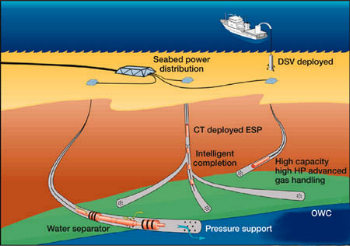
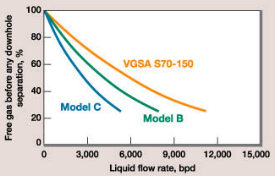
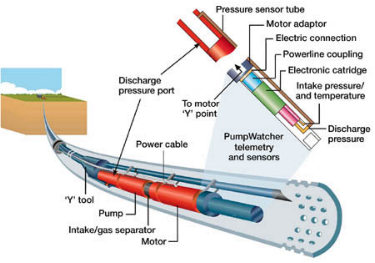
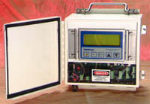
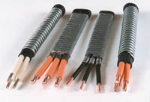
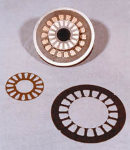

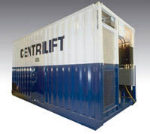

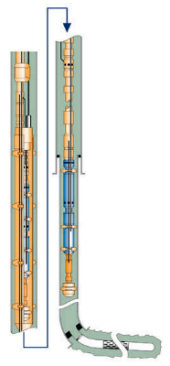
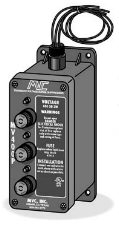
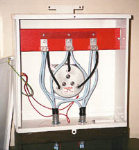
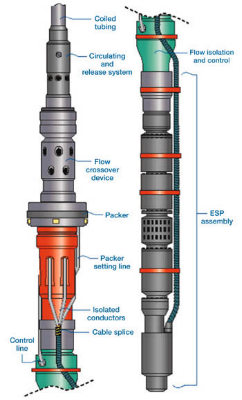
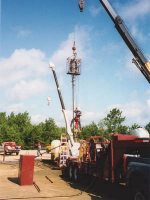
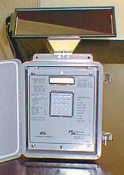
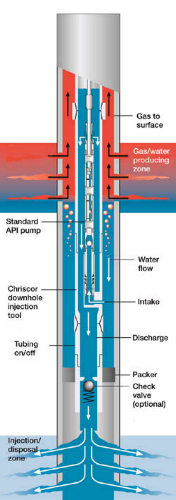
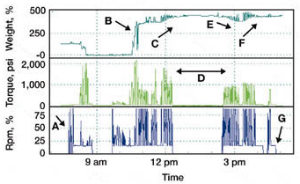
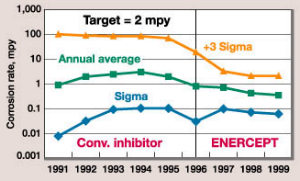
 James
F. Lea, professor, chairman of Petroleum
Engineering, Texas Tech University, Lubbock, holds BS/MS degrees in ME from the University
of Arkansas and a PhD in ME from Southern Methodist University. He worked for Sun Oil Co. as
a research engineer from 1970 to 1975; from 1975 to 1978, he taught engineering at the
University of Arkansas; and from 1979 to 1999, he was leader of optimization and artificial
lift at Amoco EPTG. He assumed his present position in 1999. Mr. Lea is a registered
professional engineer in Texas; he has authored / co-authored several patents, as well as
publications on artificial lift.
James
F. Lea, professor, chairman of Petroleum
Engineering, Texas Tech University, Lubbock, holds BS/MS degrees in ME from the University
of Arkansas and a PhD in ME from Southern Methodist University. He worked for Sun Oil Co. as
a research engineer from 1970 to 1975; from 1975 to 1978, he taught engineering at the
University of Arkansas; and from 1979 to 1999, he was leader of optimization and artificial
lift at Amoco EPTG. He assumed his present position in 1999. Mr. Lea is a registered
professional engineer in Texas; he has authored / co-authored several patents, as well as
publications on artificial lift. Herald
W. Winkler is former chairman, now professor
emeritus and research associate, in the Department of Petroleum Engineering at Texas Tech
University in Lubbock, Texas. He is presently working as a consultant in artificial lift,
specializing in gas lift.
Herald
W. Winkler is former chairman, now professor
emeritus and research associate, in the Department of Petroleum Engineering at Texas Tech
University in Lubbock, Texas. He is presently working as a consultant in artificial lift,
specializing in gas lift. Henry
V. Nickens graduated from Louisiana State
University (BS, physics), University of Southern Mississippi (MS, mathematics), Carnegie
Institute of Technology (MS, nuclear engineering) and Louisiana State University (PhD, fluid
mechanics). Dr. Nickens has worked as a nuclear engineer for Westinghouse Electric Naval
Reactor Division. He joined Amoco in 1981, where he has researched well control, drilling
fluid hydraulics, artificial lift, optimization and software development. He is currently
with BP Amoco, in Houston, on the Integrated Asset Modeling team.
Henry
V. Nickens graduated from Louisiana State
University (BS, physics), University of Southern Mississippi (MS, mathematics), Carnegie
Institute of Technology (MS, nuclear engineering) and Louisiana State University (PhD, fluid
mechanics). Dr. Nickens has worked as a nuclear engineer for Westinghouse Electric Naval
Reactor Division. He joined Amoco in 1981, where he has researched well control, drilling
fluid hydraulics, artificial lift, optimization and software development. He is currently
with BP Amoco, in Houston, on the Integrated Asset Modeling team.
